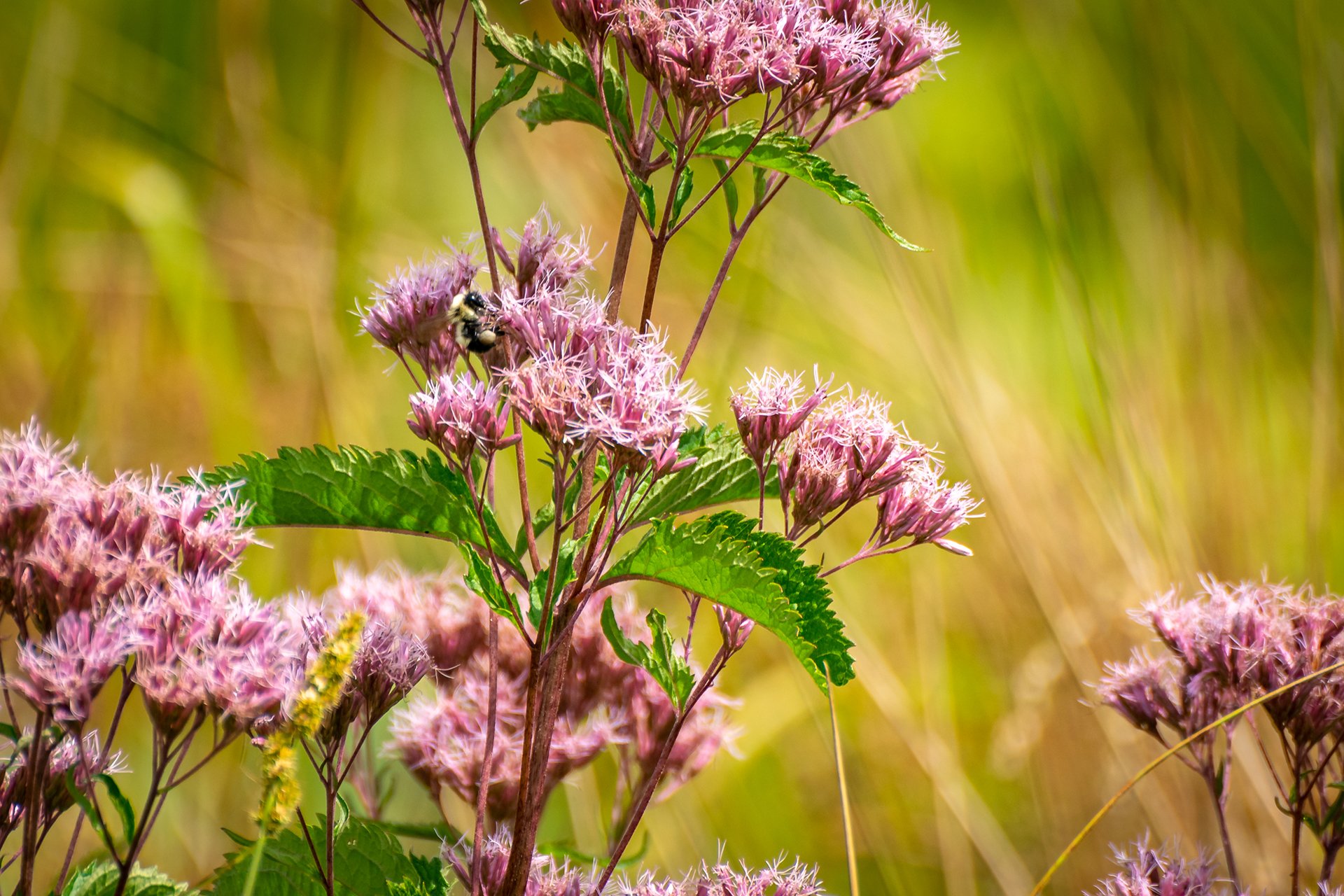Native & Beneficial Plants
Native plants support pollinators such as hummingbirds, bees, and butterflies, but they also create a foundation for the entire local food chain. Many insects eat only native plants as larvae, and most birds rely on insects for part of their life. Even backyard seed-eating birds like chickadees and finches raise their young almost exclusively on caterpillars.
Because backyards and lawn grass occupy over 40 million acres of the US, homeowners have the collective power to conserve biodiversity with their landscaping choices. Replacing lawns with native plants and avoiding yard chemicals are important ways to strengthen local ecosystems, one backyard at a time.
Wildlife & Pollinator-Friendly Plants
*native to Northeast but non-native to Massachusetts
Floral Plants Native to New England
- Smooth beardtongue, Penstemon digitalis
- Wild Columbine, Aqueligia canadensis
- Coral bells, Heuchera americana*
- Goat’s Beard, Aruncus dioicus
- Wild Geranium, Geranium maculatum
- Canada anemone, Anemone canadensis
- Rue Anemone, Thalictrum thalictroides
- Wild Lupine, Lupinus perennis
- Bird’s Foot (and other Violets), Viola pedata, etc.
- Lowbush blueberry, Vaccinium angustifolium
- Bearberry, Arctostaphylos uva-ursi
- Golden groundsel, Packera aurea
- Swamp Milkweed, Asclepias incarnata
- Butterfly Weed, Ascelpias tuberosa
- New Jersey Tea, Ceanothus americanus
- Hoary Mountain Mint, Pycnanthemum incanum
- Narrow-leaved Mountain Mint, Pycnanthemum tenuifolium
- Clustered Mountain Mint, Pycnanthemum muticum
- Obedient Plant, Physostegia virginiana* (can spread aggresively)
- Northern Blazing Star, Liatris scariosa
- Wild Bergamot, Monarda fistulosa
- Spotted Beebalm, Monarda punctata
- Culver’s Root, Veronicastrum virginicum
- Golden alexanders, Zizia aurea
- American spikenard, Aralia racemosa
- Ohio spiderwort, Tradescantia ohioensis
- Cardinal Flower, Lobelia cardinalis
- Trumpet honeysuckle, Lonicera sempervirens
- Wild Indigo, Baptisia tinctoria
- Virginia Rose, Rosa virginiana
- New England Aster, Symphyotrichum novae-angliae
- Aromatic Aster, Symphyotrichum oblongifolius (formerly Aster oblongifolius)
- Smooth Aster, Symphyotrichum laeve (formerly Aster laevis)
- Calico Aster, Symphyotrichum lateriflorum (formerly Aster lateriflorus)
- White Woodland Aster, Eurybia divaricata (formerly Aster divaricatus)
- Woodland Sunflower, Helianthus divaricatus
- Pale-leaved Sunflower, Helianthus strumosus
- Turtlehead, Chelone glabra
- Great Blue Lobelia, Lobelia siphilitica
- Cut-leaf Coneflower, Rudbeckia laciniata
- New York Ironweed, Vernonia novebracensis
- Joe Pye Weed, Eupatorium maculatum
- Boneset, Eupatorium perfoliatum
- Sneezeweed/Helen's Flower, Helenium autumnale
- Dwarf honeysuckle/Bush honeysuckle, Diervilla lonicera
- Foamflower, Tiarella cordifolia
- Wild strawberry, Fragaria virginiana
- Common Yarrow, Achillea millefolium
- Barren strawberry, Geum fragarioides (formerly Waldsteinia fragarioides)
- Goldenrods, various, Solidago spp.
Grasses Native to New England
- Prairie dropseed, Sporobolus heterolepis
- Little bluestem, Schizachyrium scoparium
- Switchgrass, Panicum virgatum
- Sideoats Grama, Bouteloua curtipendula
- Tufted Hairgrass, Deschampsia cespitosa
- Wavy Hairgrass, Deschampsia flexuosa
- Pennsylvania Sedge, Carex pensylvanica
Shrubs & Small Trees Native to New England
- Winterberry Holly, Ilex verticillata
- Inkberry
- Sweet Pepperbush, Clethra alnifolia
- Swamp Azalea, Rhododendron viscosum
- Chokeberries, Aronia spp.
- American Hazelnut
- Spicebush
- Viburnums – several native options
- Dogwoods – Gray, Silky, Red-twig, Pagoda, Flowering
- Redbud
- Buttonbush, Cephalanthus occidentalis
Plants Fruit-Eating Birds Love
- Mulberry (summer)
- Black Cherry (late summer)
- Viburnums (summer) 3-4 native species
- Dogwoods 4 native species
- Pokeweed (late summer/fall)
- Black Tupelo
- Virginia Creeper (late summer/fall)
- American Holly (winter)
- Winterberry & Inkberry hollies (winter)
- Crabapples (e.g. Zumi) fruits in winter, flowers attract spring migrants
Plants Seed-Eating Birds Love
- Evening primrose
- Asters & Goldenrods anything in daisy family
- Birches
- Native grasses various
- "Hard mast" producers (oak, beech, American Hazelnut)
- Conifers
TIP: Don't dead-head those last blooms of garden plants! Finches and sparrows will thank you.
Plants Hummingbirds Love
- Wild Columbine, Aqueligia canadensis
- Trumpet honeysuckle, Lonicera sempirvirens
- Beebalms, Monarda didyma (and other Monarda spp.)
- Cardinal Flower, Lobelia cardinalis
- Giant Hyssop, Agastache foeniculum
Important Butterfly Larval Host Plants
- Oak (especially young oaks & Bear Oaks)
- Milkweeds 4 species
- Cherry/Plum
- Grasses especially Little Bluestem
- Willow
- Elm
- Blueberry
- Sassafras
- Parsley family (Queen Anne's Lace, Yarrow, Dill, etc.)
Stay Connected
Don't miss a beat on all the ways you can get outdoors, celebrate nature, and get involved.



